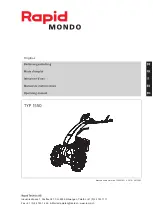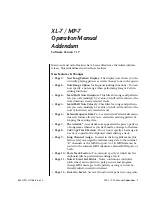
32
6 Installation
MANUAL CEAG AUtoMAtiC tEst systEM At-s
+
40071860177 (C) December 2016 www.ceag.de
6.3 Installation
•
Isolate all connecting cables and lock them out (e. g. by
removing all fuses and proper securing of the mains
supply distribution board using warning signage and/or
locks).
•
Run the connecting cables to the control cabinet posi-
tion with an adequate length allowance (e. g. for instal-
lation in the cable trunking inside the cabinet). This work
must be carried out properly according to the relevant
standards and codes of practice.
•
Secure all cable entries with the M-type glands
provided.
ATTENTION!
This figure shows the outgoing cables for the mains
supply of slave stations mounted on C-section rails on the
cabinet wall (part no. 400 71 347 126) using appropriate
cleats. Leave no connecting cables temporarily loose and
unsecured!
Subsequent additions or modifications to the component
layout are possible; such work on the internal layout of the
cabinet is not described in this manual however as is must
be carried out by specially trained CEAG engineers!
The installation and connection of the general lighting
system is not described in this manual. Lighting equip-
ment must be assembled, run and connected according
to the relevant electrical engineering standards and codes
of practice. You must also comply with all standards and
directives of the country in which the system is installed
and operated.
6.4 Connection to mains
6.4.1 Connection to mains supply of a AT-S
+
station
Power supply of a AT S
+
system is via the supply grid of
the power source for safety services.
Connecting the cables for the mains supply to the AT-S
+
control cabinet:
•
Ensure that the system and feeders are isolated and
locked out!
•
Connect the earth conductors to the PE terminal block
(pos. 5).
•
Connect the neutral conductors to the N-terminal block
(pos. 4).
•
Connect the load conductors to the L-terminals (pos. 7)
on the disconnector
ATTENTION!
For single-phase operation, a load-current cable only is
connected, and the input terminals (pos. 7) on the discon-
nector are jumpered.
1
4
2
3
5
6
7
8
ATTENTION!
Do not close the cabinet door if the load break switch is
open, as the door may hit against it.
Load disconnector (1)
(terminal box and fuse
box for the mains
supply)
Outgoing distributor (2)
Cabinet distributor (3)
N-terminal block (4)
PE-terminal block (5)
Connections shown
with load disconnector
cover removed
Connection cables for
the busbar (mains) at
the back (6),
mains supply feeders
for the AT-S+ C station (7),
outgoing feeders for the
mains supply of AT-S+ S (8)
















































